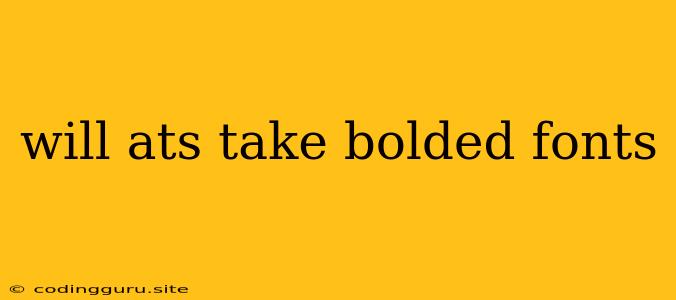Will ATS Take Bolded Fonts?
Applicant Tracking Systems (ATS) are software used by recruiters to sift through large volumes of resumes. They parse resumes for keywords and other important information, making the hiring process more efficient. But with the rise of ATS, many job seekers wonder if formatting choices, like using bold font, will actually hurt their chances of getting noticed.
The short answer is: it depends. While some ATS systems are very sensitive to formatting and might ignore bold text, others can handle it without issue. Here’s a breakdown of how to navigate the bold font dilemma in the age of ATS:
Understanding How ATS Scan Resumes
ATS systems are primarily designed to read and understand the content of a resume. They use algorithms to scan text for keywords, skills, and experience, ignoring formatting elements like bold, italics, or color. They focus on:
- Keywords: Matching your resume's keywords to the job description is crucial for ATS success.
- Skills: Listing relevant skills clearly and concisely is another key factor.
- Experience: ATS systems look for specific work experience and job titles that match the job posting.
Why Some ATS Might Not "See" Bold Fonts
While many modern ATS systems are capable of handling basic formatting, some older systems might not be as advanced. These older systems might struggle with:
- Overuse of Bolding: If you use bold text excessively throughout your resume, the ATS might get confused and miss important content.
- Unusual Formatting: Highly stylized or creative formatting, like using bold for every word in a section, can make it difficult for the ATS to parse the document.
Tips for Using Bold Fonts Wisely
While you don't want to overdo it, using bold font strategically can improve your resume's readability and highlight important information. Here are some best practices:
- Headline: Bolding your name and job title makes them stand out.
- Section Headers: Use bold for section headers like "Experience" or "Skills" for easy navigation.
- Key Skills: Highlighting a few essential skills within the skills section using bold can draw the reader's eye.
- Quantifiable Achievements: Bolding numbers or percentages used to quantify your achievements can emphasize your impact.
Focusing on Content over Formatting
The bottom line is that content is king. While formatting can enhance readability, it's ultimately the substance of your resume that matters. Focus on:
- Relevant Keywords: Tailor your resume to each job description.
- Clear and Concise Language: Use bullet points to present your experience effectively.
- Quantifiable Results: Highlight your accomplishments with numbers and data.
- Proofreading: Thoroughly proofread your resume for errors and typos.
The Importance of Keeping It Simple
The best approach is to stick to basic, clean formatting. Use bolding sparingly and primarily for headings, key skills, and quantifiable achievements. This way, you're ensuring both ATS and human recruiters can easily digest your information.
In Conclusion
While there are concerns about ATS systems and bold fonts, the key is to use it judiciously. Focus on creating a resume that's both readable and informative, prioritizing content and clarity over flashy formatting. By mastering the art of keyword optimization and clear communication, you can build a resume that stands out in the crowd, even without the boldest of fonts.
